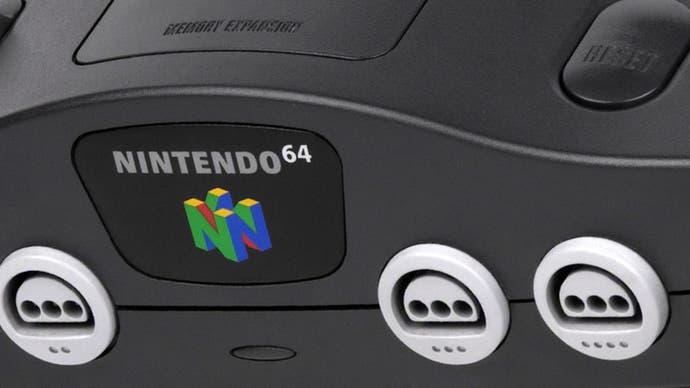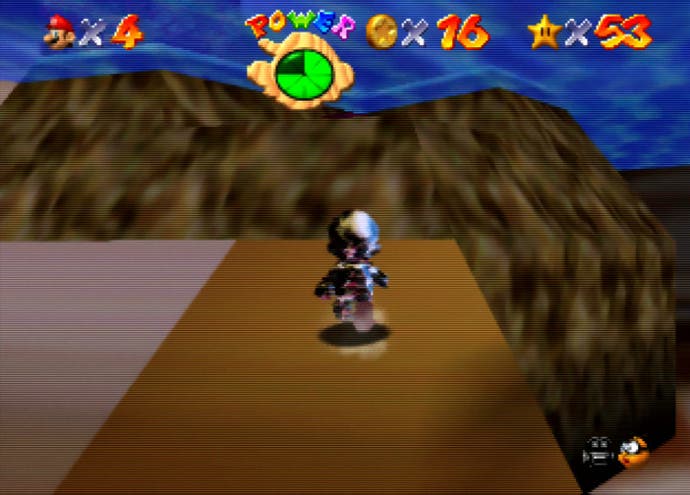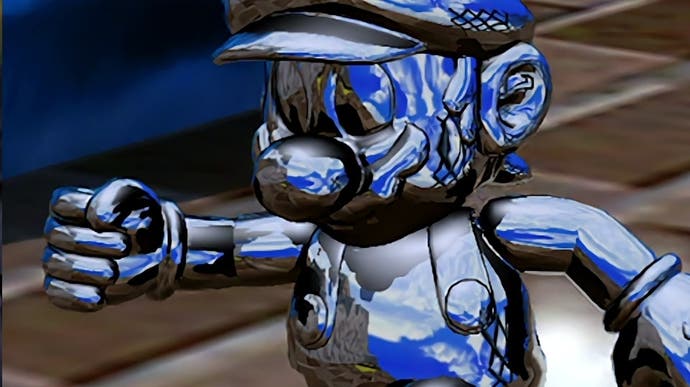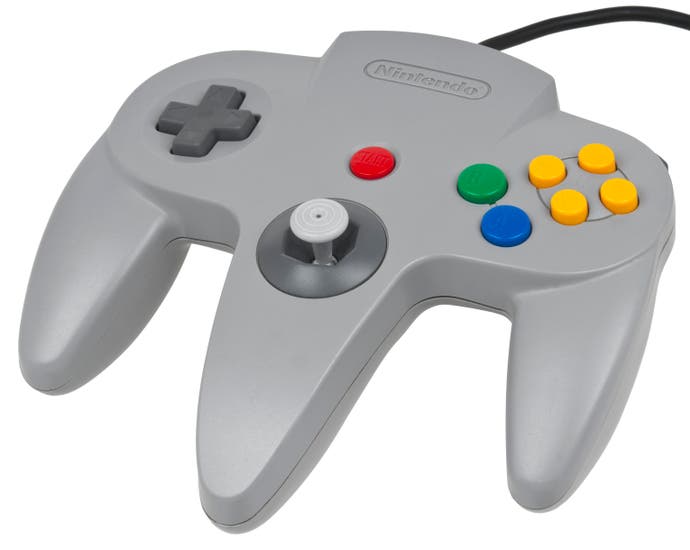When Nintendo went Hollywood: a casual conversation with the man who helped shape the N64
Happy 25th to one of Nintendo's most important consoles.
Somewhat inexplicably, it is a quarter of a century since the Nintendo 64 first appeared in Japan - marking the beginning not just of Nintendo's first proper foray into 3D, but also the start of a whole new era of video games. It's far from Nintendo's most successful console, and with a relatively slim number of titles it's perhaps not one of its most beloved either, but there's a strong case to be made for the N64 being one of Nintendo's most important pieces of hardware.
Working within Nintendo back then was Giles Goddard, who'd helped push Nintendo into 3D with his work on Star Fox at Argonaut before he decamped to Kyoto to join the company full-time. It's here that Goddard worked on 1080° Snowboarding, the extreme sports game that went on to become beloved by many - and it's territory he's since returned to with Carve Snowboarding, which recently released on Oculus Quest to critical acclaim, while elsewhere his studio is lending its talents to Playdate with the California Games-esque Whitewater Wipeout.
As the N64 approached this milestone anniversary, we spent a short while reminiscing about the console and its legacy with a man who was able to witness it all first-hand.
I don't know if you're the kind of person who keeps anniversaries in their heads, but the Nintendo 64 turns 25 this month.
Giles Goddard: So I heard, yeah. So when was that?
It was 1996. I remember because I spent all summer working at an indoor kart track breathing in a load of asbestos to be able to buy one of the things, they were so expensive. When you joined Nintendo the N64 was still being prototyped I guess?
Giles Goddard: I became full time when they were winding down the SNES and just starting to think about the N64 - in fact, I think the reason they didn't release Star Fox 2 is because it would coincide with the launch of the N64.
Do you remember the first conversations around it?
Giles Goddard: It was all the R&D2 group, I think - [Genyo] Takeda's group. They were assigned the task to make the new platform and they couldn't just put MARIO Super FX chips in everything [designed by Argonaut where Giles made first contact with Nintendo, the Super FX chip was included in SNES cartridges and enabled the primitive 3D of titles such as Star Fox and Stunt Race FX].
They knew they couldn't do it themselves. So that's why they went to Silicon Graphics because they were the graphics people at the time - they were making the expensive workstations for films and whatnot, so they were the obvious choice to go for.



It was called Project Reality, wasn't it?
Giles Goddard: It was, wasn't it? I forgot about that. The idea was every time they released a platform it became almost like reality, if you know what I mean. So every leap was the new best thing. Obviously, compared with stuff we've got nowadays it's nothing. Silicon Graphics were all about the high quality lighting and texturing and all this stuff, so that's where the reality bit came from.
I remember seeing an early render of Mario in a town - by today's standard it looks terrible, but it blew my mind how realistic it looked then. What was it like for you working on it - it must have been quite a leap going from working on the SNES to working on something which I assume was at the time was quite powerful.
Giles Goddard: Yeah, it was the pro stuff. We'd gone from a tiny studio flat in London with the FX chip - because basically the FX chip was designed in a flat in London at Argonaut. We went from that to the mega offices at Silicon Graphics with their supercomputers and Indigoes [a powerful workstation from SGI], and their massive knowledge of 3D hardware.
It was a major step up. It was like jumping into a Hollywood movie - the first time I went to Silicon Graphics, they had just announced the partnership with what became DreamWorks, headed up by these big Hollywood names Steven Spielberg, Jeffrey Katzenberg and David Geffen. They'd just announced this massive tie up with Silicon Graphics, and they were going to provide the tech for something like the next 10 films. It felt like being in Hollywood.
Did you spend quite a lot of time over there at Silicon Graphics as part of that process?
Giles Goddard: It was quite a few times - every couple of months we'd pop over, or they'd come over here.
What was that partnership like? I'm not sure if Nintendo had ever worked so closely with a Western partner like that in hardware development.
Giles Goddard: Yeah, it was quite close actually. Because Takeda-san and his lot were always over there - they were very much embedded within Silicon Graphics. Compared with something like Argonaut it was very much a joint thing rather than just Nintendo outsourcing the thing.
I think Nintendo really wanted to make sure the hardware that was getting designed was going to fit the games they wanted to make. So part of my team's job was to tell Silicon Graphics what we wanted from the hardware - otherwise Silicon Graphics would have gone down a route that doesn't really suit games, because Silicon Graphics weren't a games company, they were a movie graphics company. They didn't really care at that point about real time graphics as such. All they cared about was the quality of the graphics.
So did that involve prototyping games to get some idea of what you wanted?
Giles Goddard: We spent a year or so just making prototypes of potential games or potential tech that we'd like to see in a game.
Did any of that stuff find its way into the games?
Giles Goddard: Nearly all of the tech side of things did - things like the lighting, the inverse kinematics and the skinning, that was all tech that was designed to run on the N64. We didn't actually have any final hardware for a long time, so what we were doing is we had a huge On supercomputer in the backroom at Nintendo that was basically emulating what the hardware would be eventually. That was quite a good system, because they would just update the hardware virtually. And we could test out on a virtual N64, which was really cool.
It sounds hugely exciting, being able to see and to help define the console as well. 3D games were still in their infancy - what were you looking at in terms of inspiration?
Giles Goddard: Films, probably - things like Terminator 2 and stuff like that. You'd look at that and think that's so cool, how do we do that in real time? Specifically, the T-1000 - that was the big thing of the early 90s, which was actual environment mapping. In Terminator 2 you could see the sparks coming off the molten metal machine, you can see the sparks in the reflection of the guy. They kind of used it a bit too much where you can see the reflection of a policeman in the T1000. They kept making the point that they could do real time reflection on this virtual object.
What I didn't realise at the time was that a lot of what they did there wasn't actually CG. It was actually just a tinfoil head.
Really? That's cheating.
Giles Goddard: And it's done so seamlessly you just don't think that okay, this bit is CGI, this bit's actually real.
So you could spend months wondering how they did it only to realise it was tinfoil?
Giles Goddard: Yeah, they just cheated! It's like a lot of Christopher Nolan movies nowadays - you assume everything is CGI but actually only a tiny bit is CGI, the rest of this actually happening. It's a great way to get inspiration.
Yeah, totally. Moving forwards a bit, obviously the N64 went with cartridges when everyone else was going with CD. Obviously there was some history behind the decision, with what happened with the Nintendo PlayStation informing all that. Do you remember the thinking behind it all, and how difficult a decision it was to make?
Giles Goddard: If I was cynical, I would say it was entirely for the profit side of things. You can charge 7000 yen for an actual physical cart, but it was quite difficult to charge different amounts for a CD. Because the perception was that CDs are just pieces of plastic.
There's also obviously the loading times - from a player's point of view, loading times suck, and there were no loading times with carts. But it definitely felt like we were lagging behind the tech there, because everything was moving to CD at that point - films and music and everything. Nintendo were the people that were sticking with these really old fashioned old cartridges, and it felt like we were really lagging behind. But I think it was the right move in the end.
Obviously commercially it made sense - in what other ways was it the right move?
Giles Goddard: There's so many more things you can do with a cartridge that you can't do with a CD. Obviously, you don't have endless amounts of space so you have to think about how much you're going to put into the game. But the fact that you can load in parts of the game instantly without having to wait for the CD to do it is really powerful. 1080 Snowboarding wouldn't have been as smooth as it was without the cartridge.
Nintendo's marketing at the time really lent into some of that - I remember full-page ads about the speed of silicon cartridges against slow CDs. I remember at the time being convinced it was a good thing!
Giles Goddard: Everybody at the time was awestruck with how cool CDs were to think of the downsides too much.
It's also one of those very Nintendo things to do something contrary like that.
Giles Goddard: Yeah, that was the Nintendo which was always trying to do something different to what everybody was expecting.
What was the first game you worked on for it?
Giles Goddard: That would have been Mario, I guess.
How involved were you in the development of Mario 64?
Giles Goddard: When we were doing the initial prototypes, with Mario's face and stuff like that, we were quite hands on. But when it started getting into the actual gameplay side of things, it was very much left to the Mario team. But we were using the same API and tech and whatnot.
I always think Super Mario 64 is such a phenomenal thing in how it solved the 3D issue so seamlessly.
Giles Goddard: For a long time they didn't really know what it was supposed to be. They knew they didn't want to have this flat version of Mario and make it isometric, because that would just be crap. They didn't want it on rails like Star Fox where he will only ever move forward. So it's quite difficult to figure out what it actually meant to be a free roaming 3D game and all the problems that entails - what do you do with the camera, you can't expect the player to control it, so where do you put it? All these sort of new issues that came up because of that game.
It did a fantastic job at solving so many of them as well. What did you move onto after that?
Giles Goddard: Let me just check my Wikipedia page. I don't know who made it, but it's very accurate.
Won't your Nintendo Fandom page be more accurate? Actually I'm just doing a search now and all I've come up with is a priest.
Giles Goddard: For some reason if you search for Giles Goddard, which I did literally yesterday, one of the first things I came up with was how much is Giles Goddard worth. The priest is worth $2 million dollars. How is the priest worth $2 million? I'm in the wrong business.
So you moved on to 1080 Snowboarding. How did you manage to head up your own project?
Giles Goddard: I guess I made a name for myself at that point with Star Fox and the tech demos and all that sort of stuff. I was very much kind of seen as the new tech guy at EAD for a while. So it was quite easy to show them a new bit of tech - in 1080's case it was inverse kinematics with the skinning stuff.
They were always looking for brand new ideas to make games off. It wasn't so much that I stood up and wanted to make a snowboarding game - we had this IK tech, we made a skiing game where you ski down a hill and it animates without me having to do anything. It's this very organic way of making a game.
It was done in around 9 months, which seems extremely quick - though I guess the projects you're working on now with Oculus and PlayDate aren't that dissimilar in terms of turnaround.
Giles Goddard: I think we were lucky because it was the culmination - I say it was nine months but it wasn't from scratch as I'd built all this tech beforehand. You don't really need more than nine months to make a game, really. If you keep the scope realistic, and you don't go down alleyways and rabbit holes of experiments, you can actually keep it quite on track. And also if the team gels - that's why 1080 was such a good project because everybody gelled. We were lucky I guess.

People loved it and still do - I know you still get asked about it often.
Giles Goddard: I'm taking part in a speedrun thing on it in a couple of weeks, and I'm a bit terrified of that because I haven't played it. And all I see now is just bugs. It's hard for me to play because all I see are the mistakes. I don't really need to play it because I've had it in my head for so long, I kind of know how it all works internally. I don't really need to go back because it's already running in my head.
That's incredible. What's the N64 emulator like in there - is it accurate?
Giles Goddard: There's something about programmers getting this weird thing where if you're stuck in a problem during the day, and you've been doing it for like a week, whatever. All you can think about is that one problem and then you go to bed one night, and you actually end up programming asleep. And you hit run in your sleep and it works. And then you go back to the next day. And the answer is in your dream again.
How do you look back upon the N64 now? For me it's always felt like a really important machine in terms of pushing the medium forward. But how do you view it?
Giles Goddard: For it was the start of console 3D - there was the N64 and the PlayStation, the two distinct platforms. And for a long time, everybody was obsessed with the amount of polygons that you could draw. It was all people talked about - it was Sony saying, we can draw 100,000 polygons a frame or whatever it was, it was all about the stats on the Sony side. Then on the Nintendo side, it was all about, you know, look at the quality of these pixels that are anti-aliased, they're lit and textured correctly. It was great. You had these two completely different ideas of what console 3D should be happening at the same time.
Which one ended up taking hold - which one proved to be most successful?
Giles Goddard: It turns out that neither was correct. Well, it's not that neither was correct - it just turned out it was a thing that neither side should have been pushing. They're both valid points. They're both valid things to have in a console. You know, Sony had huge amounts of polygons they could throw at it, but the textures were always wonky and warped, there was no filtering on the textures. Bilinear filtering was a big thing promoted on the N64, where the texture nicely blends together into the distance. The PlayStation didn't have that so everything just looked really jaggedy.
It was the only time that you would have seen that difference because you had a finite amount of silicon. And you could go two routes - you could either go the draw as many polygons as possible route or draw the nice pixels route. You didn't really have many options - you'd have to choose one or the other. But nowadays, it's a moot point. For me it was very much of it all, so I have huge affection for those games.
It's a hell of a legacy, too, in terms of pushing things forward.
Giles Goddard: It's definitely my favourite console. Whether it was the best one or not doesn't really matter. For me, it was the one with the most character.
That's the thing - it had its own character, there's nothing quite like it in terms of the aesthetic of its games.
Giles Goddard: You can tell SNES games, you can tell an N64 game - you can't really tell what a Switch game is anymore. You can't tell what any of the new games are anymore. But it was one of the first consoles that you could see definite differences.
It's a good point actually - you don't get that sort of character in modern hardware anymore.
Giles Goddard: [grabs PlayDate] That's why this is such a cool thing because it's kind of it doesn't try to do what it can't do. It's not trying to be more than what it is.
Chuhai Labs' Carve Snowboarding is out now on Oculus Quest, while Whitewater Wipeout will be part of the first season of games coming to Playdate later this year.



